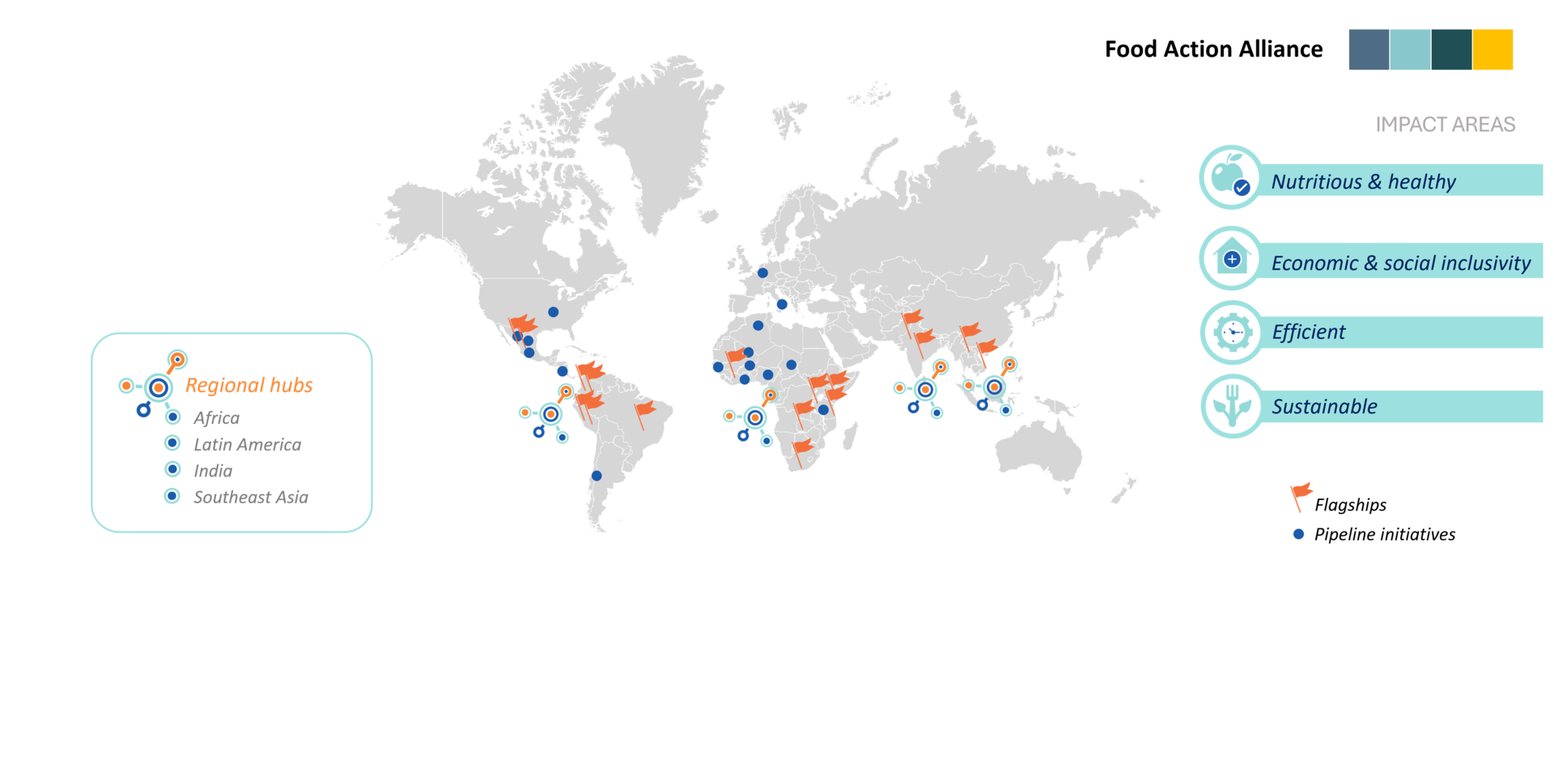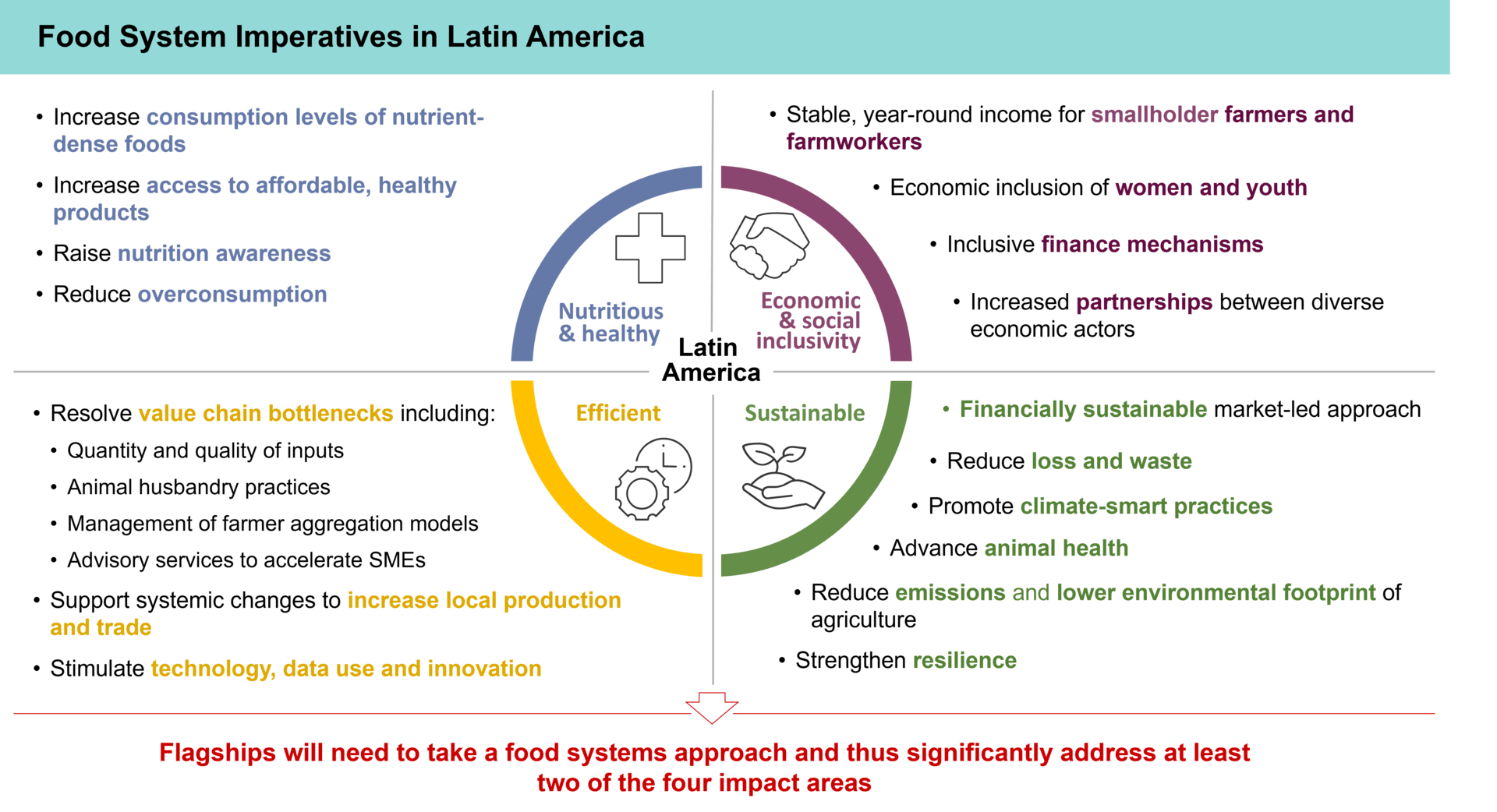Blog How the Alliance is transforming Latin American food markets

The Food Action Alliance (FAA), a global food systems initiative facilitated in Latin America by the Alliance of Bioversity International and CIAT, promotes market-driven sustainable food systems transformation.
By: Dylan Anderson-Berens
The Food Action Alliance (FAA) was established in 2019 by WEF, Rabobank and IFAD as a delivery mechanism for food systems transformation to achieve the Sustainable Development Goals (SDGs), responding to repeated calls at the World Economic Forum (WEF) annual meeting in Davos. Given its track record on food systems in Latin America, The Alliance of Bioversity International and CIAT was selected as the secretariat to establish and coordinate the Latin America and Caribbean regional hub in implementing the initiative, and its partner platform.
Due to the slow progress on SDGs and entrenched food systems challenges, a multi-stakeholder, cross-sectoral, and market-based mechanism is needed to drive meaningful change – and ultimately help us realize the 2030 Agenda, avoiding climate change’s worst effects. The FAA is just this: an action-oriented alliance of diverse stakeholders that galvanizes an ecosystem of flagship projects to collectively deliver tangible impact at scale. It has been publicly endorsed by the UN Food Systems Summit (UNFSS) Secretary as an official mechanism for action for food systems transformation.

The FAA will serve as a launchpad for the long-term continuation of the UNFSS goals toward delivering the 2030 Agenda (read more about CGIAR participation in UNFSS here). Five UNFSS Action Tracks identified thousands of game-changing propositions, integrated across 15 Action Areas and now clustered thematically into 58 solution clusters. These clusters will form working groups to promote investment proposals supporting countries’ efforts towards more sustainable food systems. Existing and emerging flagships are being supported by FAA global and regional hubs to engage in the relevant UNFSS solution cluster working groups and action coalitions, and FAA is monitoring the unfolding process of UNFSS in order to promote the most meaningful engagement for its partners.
Besides the buzz of UNFSS, the FAA is relevant because, through its flagship projects, it is able to respond to food system imperatives in the region by weaving objectives of varied partners into multi-stakeholder projects to address the needs of the food system. It demonstrates a new model for development and responsible business, as Food Systems provide a framework for addressing broader impact than projects may have contemplated up to this point.
The FAA portfolio will drive systemic change across all four of its impact areas (depicted below and contextualized in Latin America), while FAA’s flagships take a Food Systems approach, addressing two or more impact areas:
- Inclusive: Ensuring economic and social inclusion for all food system actors, especially smallholders, women, and youth
- Sustainable: Minimizing negative environmental impacts, conserving scarce natural resources, and strengthening resiliency against future shocks
- Efficient: Ensuring that sufficient food is produced and available for the world’s population
- Nutritious and healthy: Promoting consumption of a diverse range of healthy, nutritious, and safe foods
FAA Latin America Hub’s growth is supporting transformative food systems initiatives.
The food systems of the Latin America region are marked by idiosyncratic imperatives that orient FAA portfolio development.

The Alliance’s research and multi-stakeholder facilitation role during the FAA foundational period was critical in identifying food systems imperatives and building market-driven coalitions to mitigate food system failings.
Out of that process, three flagships launched in May 2020:
- Sustainable Cattle Landscapes Colombia
- Beef and Forests: Brazil-China Green Trade Opportunity
- Colombia Food Innovation Hub
The global public good that is the Amazon rainforest and the countries of Brazil and Colombia emerged as initial priority topics and geographies. FAA Partner the Tropical Forest Alliance leads efforts to develop deforestation-free value chains to conserve the Amazon through viable business models with its signatories. More effective innovation ecosystems in Colombia from farm to fork were likewise targeted. This effort, led by PepsiCo, the Alliance of Bioversity International and CIAT, WEF and the Sociedad de Agricultores de Colombia, led to the launch of the Colombia Food Innovation Hub. Once in place, flagships underwent working group formation that aided in coalition building – with new actors has come iterative project design. Food systems assessments and investment case design have supported fundraising for implementation. In a subsequent blog, we will dig deeper into the work of these flagships.
Following the launch of its first three flagships, the FAA Latin America hub conducted a portfolio gap assessment to identify remaining critical food systems imperatives, geographies, crops, themes, and flagship anchor organization types to guide subsequent portfolio development. It solicited proposals and conducted stakeholder interviews to align objectives in flagship submissions. On its June 16, 2021 Partners Group Meeting six flagships were proposed and subsequently refined for review by the FAA Steering Committee which approved four additions to the portfolio: International Potato Center (CIP) Peru Aguapan Project, Olam Peru Superfoods Initiative (Quinoa and Chia), VIDA (Mexico), and CIMMYT’s Maize for Mexico. Current pipeline initiatives include proposals from Unilever and Rainforest Alliance-Olam among others. We dive deeper into their design and impact in our second and third blog.
Benefits of joining the FAA as a strategic or affiliate partner

FAA partners receive a number of unique benefits through engaging with the FAA and its flagships. These include: 1) The opportunity to drive systemic change by helping to incubate and scale groundbreaking, transformative initiatives; 2) Participation in a portfolio of flagships, positioned to mobilize investments and partnerships; and 3) Recognition as a thought leader in the food and agriculture space. In addition, FAA convenes thematic working groups to accelerate learning and knowledge flows. One example is the Finance Working Group for Latin America that exists to identify and scale financial instruments for food systems transformation.
For information on the FAA, reach out to Dylan Anderson-Berens or Mark Lundy.
In the upcoming blogs in this series, we will look at 1) the Latin American food systems imperatives guiding portfolio development 2) how flagship admission criteria developed by the FAA ensure a food systems approach is delivered at scale 3) a deeper dive into the FAA flagships as multi-stakeholder, market-driven vehicles of food systems transformation and 4) How the FAA relates to the UNFSS.
Read the other stories in this series:
- How the Food Action Alliance designs and selects Flagships that take a food systems approach
- The Food Action Alliance Latin America Portfolio of Flagship Food System Projects
- How does the Food Action Alliance (FAA), a global food systems initiative facilitated in Latin America by the Alliance of Bioversity International and CIAT, relate to United Nations Food Systems Summit (UNFSS)
